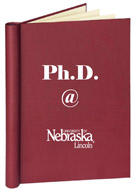Graduate Studies, UNL

Dissertations and Doctoral Documents, University of Nebraska-Lincoln, 2023–
First Advisor
George Avalos
Second Advisor
Mohammad Rammaha
Degree Name
Doctor of Philosophy (Ph.D.)
Department
Mathematics
Date of this Version
8-2024
Document Type
Dissertation
Citation
A dissertation presented to the faculty of the Graduate College of the University of Nebraska in partial fulfillment of requirements for the degree of Doctor of Philosophy
Major: Mathematics
Under the supervision of Professors George Avalos and Mohammad Rammaha
Lincoln, Nebraska, August 2024
Abstract
Fluid-Structure Interaction concerns the interaction of parabolic fluids and hyperbolic elastic structures via numerous mechanisms such as boundary coupling and pressure. These models find application in blood flow, fluid flow in the eye, and air flow over plane wings. Parabolic equations are well known for “infinite speed of propagation,” which manifests itself via a uniform bound on the resolvent of the infinitesimal generator of the associated strongly continuous semigroup. Qualitatively, a solution of a parabolic pde with rough initial data is immediately smooth for any positive time. A priori, it is not clear whether a fluid structure interaction inherits any smoothing of solutions from its parabolic component. However, given the special configuration of the geometry of interest, where the parabolic process is of one spatial dimension higher than the hyperbolic plate and the plate component evolves on a flat surface Ω, one can show that the associated fluid-structure semigroup is Gevrey class for time t ≥ 0. That is, solutions of the coupled parabolic-hyperbolic process are overall parabolic in some sense. A time dependent finite element scheme is presented for the numerical solution of this fluid structure interaction system on a convex 2D fluid - 1D structure geometry. This scheme is straightforwardly generalized to 3D fluid - 2D structure. Additionally, explicitly computable null controls which steer the fluid component of the system to rest in finite time are supplied.
Advisors: George Avalos and Mohammad Rammaha
Recommended Citation
McKnight, Dylan, "Gevrey Class Estimates towards Null Controllability of a Fluid Structure Interaction System" (2024). Dissertations and Doctoral Documents, University of Nebraska-Lincoln, 2023–. 144.
https://digitalcommons.unl.edu/dissunl/144


Comments
Copyright 2024, Dylan McKnight. Used by permission